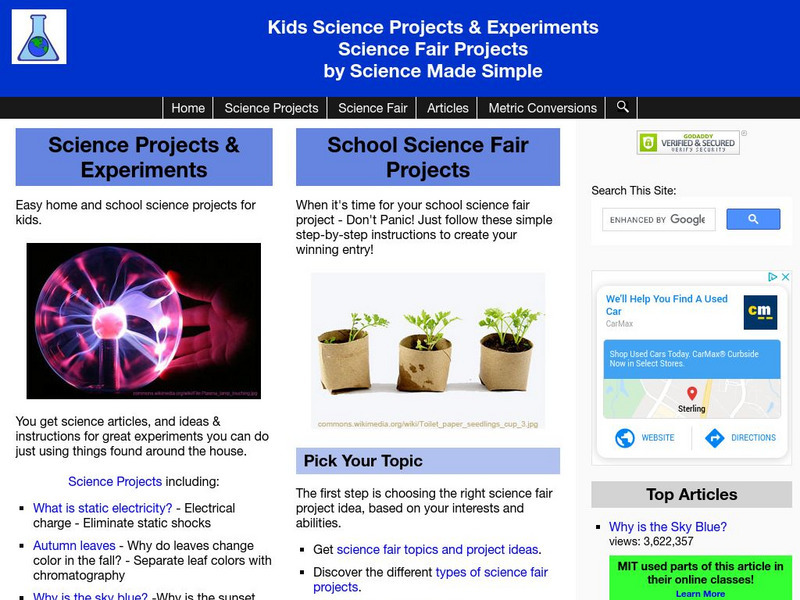Hi, what do you want to do?
Curated OER
Can you Find the Expression
Students collect data from measurements and weights for this experiment. In this algebra lesson, students analyze graphs they create form their data to find the expression representing the data. They label which graph provided the best...
Curated OER
Ptolemy, Copernicus, & the Church
Students explore the scientific revolution. In this scientific revolution instructional activity, students complete activities regarding Ptolemy, Copernicus, and the Church.
Curated OER
Families and Neighborhoods
Students build their own neighborhood. In this lesson on community, students are introduced to books about families and neighborhoods. As a class, the students create their own neighborhood, elect a leader for their neighborhood and...
Curated OER
Plotting Data on a Graph
Students investigate graphing. For this graphing lesson, students survey the class and create graphs to reflect the data collected.
Curated OER
Bias Sampling
Students explore statistics by conducting a scientific study. In this data analysis lesson, students conduct a class poll about popular foods of their classmates. Students complete a worksheet and discuss how bias opinions affect the...
Curated OER
NOVA Online/Einstein Revealed
Welcome to the companion Web site to the NOVA program "Einstein Revealed," originally broadcast in October, 1996. This two-hour special presents a penetrating profile of Albert Einstein, who contributed more than any other scientist to...
Curated OER
Fact or Fantasy Writing
First graders see that some written text is for pleasure and enjoyment while some is for relaying information. They get to experience both types during the lesson. They brainstorm ideas for a story about a new kid in school to write about.
Curated OER
Introduction to Fractals: Infinity, Self-Similarity and Recursion
Students think about several of the concepts from fractals, including recursion and self similarity. They use mathematical concepts of line segments, perimeter, area and infinity are used, and skill at pattern recognition is practiced.
Curated OER
Colonial Life
In this colonial life worksheet, learners read a 1 page article on colonial life, make a Venn diagram that shows how life for colonial children was different from and similar to theirs and discuss what part of colonial life they liked...
Curated OER
Charting Animal Life Spans
Second graders research animal life spans and complete related math activities. In this life span lesson, 2nd graders read How Many Candles and discuss life spans. Students arrange animal cards based on their life spans. Students find...
Curated OER
Creating a Shelter
First graders create a small usable shelter for a small animal or an insect. In this shelter lesson plan, 1st graders use popsicle sticks, tree twigs, bottles, and more to build a shelter in groups.
Curated OER
Second Grade English/Language Arts Quiz
In this language worksheet, 2nd graders complete multiple choice questions about sentence structure, parts of speech, dictionary work, and more. Students complete 15 questions.
Curated OER
The Very Busy Spider Art Project
Students listen to the story The Very Busy Spider and participate in an art activity related to the book. In this story inspired art lesson, students use a Very Busy Spider printable and cut out the spider's body and connect...
Curated OER
The History Of The Internet
Students explain how the Internet evolved and what it is today.
Curated OER
Build a Space Shuttle
Students explore the concept of space. In this space activity, students pretend to be aerospace engineers. Students build space ships out of cardboard tubes. Students discuss what aerospace engineers do. Students model their space ships...
Curated OER
The One in the Middle
Young scholars review and reinforce the concepts of mean, median, and mode based on the number of siblings the students have. They use Post-it notes to organize and re-organize the data.
Curated OER
Hibernating Hoopla
Young scholars simulate hibernation with their stuffed animals. They predict the length of time of hibernation and type their math journal entries about sorting, graphing and draw pictures. They read bear hibernation stories.
Curated OER
Bridges
Ninth graders use model-building to help comprehend the forces and phenomena at work in the world around them. They describe gravity as a universal force that pulls everything toward the center of the earth. Students distinguish between...
Curated OER
What Can I Do?
Students identify ways to handle conflict. In this conflict resolution lesson, students brainstorm times when they had a conflict with a friend. Students develop a strategy to deal with conflicts in the future, such as talking it through...
Curated OER
The Food Pyramid
Third graders investigate the concept of The Food Pyramid and its importance as a foundation for good health. They use the computer lab as a class to construct projects using the Kidpix software to make their own imitations of The Food...
Curated OER
Innovation of Our Generation
Students brainstorm on the different innovation in their lives today. In this technology lesson, students research one innovation and prepare a speech to convince their classmate to name it the "Innovation of our Generation." They...
Science Made Simple
Science Made Simple: Science Made Simple
This website houses kids science projects and experiments, science fair projects and science articles.
Science Made Simple
Science Made Simple: Why Is the Sky Blue?
This website has three different projects from which to choose on the topic of why the sky is blue. Also, you can scroll up to learn more about why the sky is blue.
Other
Science Made Simple: Conversions for Length Measurement
This site allows you to type in various lengths you want to covert. For example, if you want to find out how many feet there are in 10 meters, you can submit that information and get the answer.




























